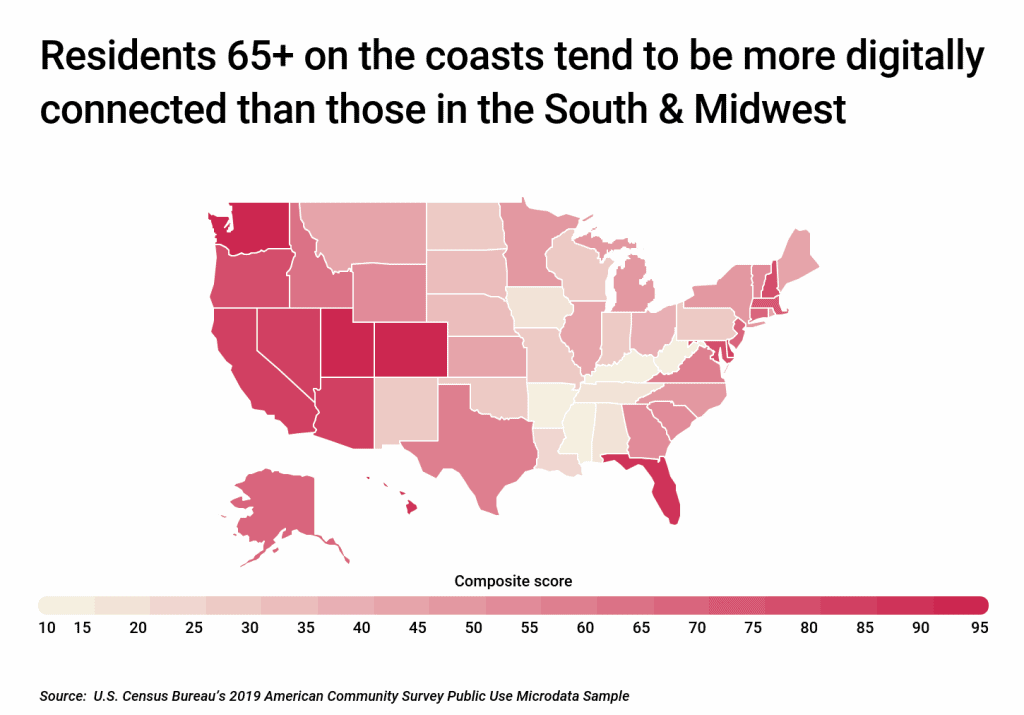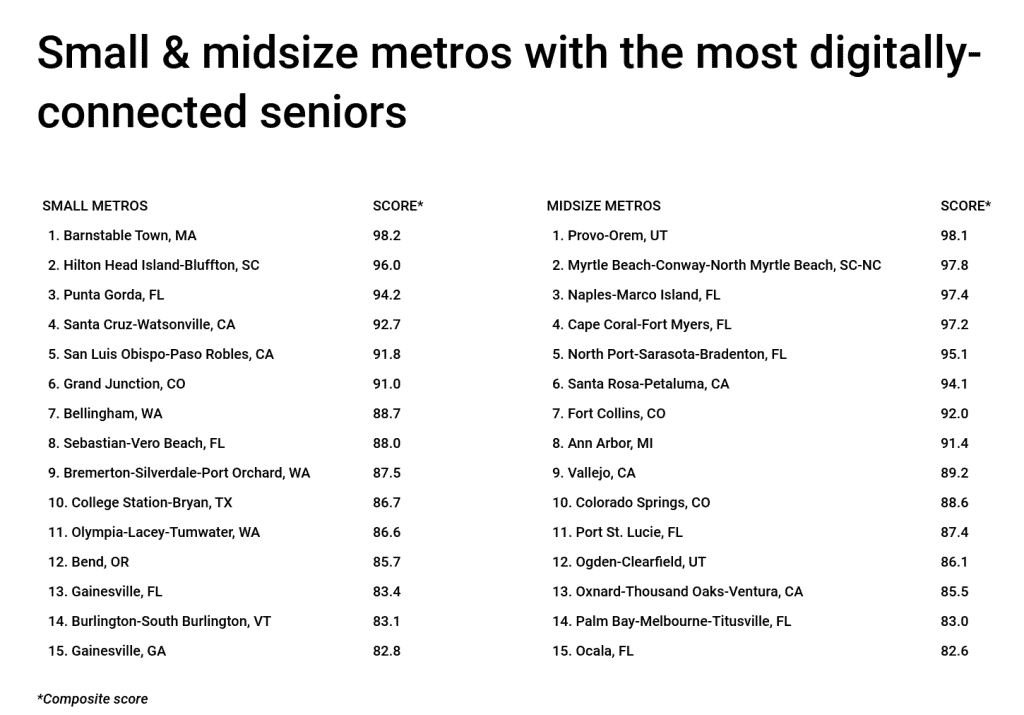Cities With the Most Digitally-Connected Seniors
Disclosure: Hotdog.com is supported by readers. When you click on our links and make a purchase, we may earn a commission at no additional cost to you. Learn more
I’ve witnessed one of the most significant and lasting transformations of our time as the COVID-19 pandemic pushed me and countless others to embrace new technologies for staying connected, enjoying entertainment, pursuing education, and performing our jobs remotely.
Older Americans generally have lower rates of technology adoption than their younger counterparts. For example, 78% of 65-and-over households have internet access compared to 89% of households overall. But seniors are more digitally connected today than ever before.
Older Americans’ Increasing Tech Usage
Technology has enabled seniors to endure some of the most trying aspects of the COVID-19 pandemic. It has done so by allowing them to stay in touch with others during isolation and providing them with access to critical services such as grocery delivery and telehealth visits.
A recent AARP report found that technology spending among older adults nearly tripled during the pandemic, and smartphones were one of the top three tech purchases for that demographic. AARP also reported that significantly more seniors texted, used video chat, and emailed during the pandemic than they did before.
While 78% of seniors have some form of internet access, just less than 60% have high-speed internet subscriptions, and 67% each have a computer and smartphone, according to the most recent Census Bureau statistics. These numbers vary widely by location and socioeconomic status.
For example, research points to a strong rural-metropolitan digital divide among older Americans. Likewise, extensive research points to low rates of technology adoption in less-educated and low-income senior households.

Geographical Differences in Senior Tech Use
To find the locations with the most digitally-connected seniors, researchers at HotDog.com analyzed data from the US Census Bureau and created a composite score based on the following factors:
- Percentage of 65+ households with high-speed internet
- Percentage of 65+ households with a computer or laptop
- Percentage of 65+ household with a smartphone
At the regional level, seniors living on the coasts and in the Mountain West tend to be more digitally connected than those living in the South and Midwest. Utah ranks highest among all states, where 65% of senior households have access to high-speed internet, 80% have a computer or laptop, and 76% have a smartphone.
Nationally, 59% of senior households have access to high-speed internet, and 67% each have computers and smartphones.
On the opposite end of the spectrum, West Virginia’s 65-and-over population ranks last among all states when it comes to digital connectivity. Just 53% of senior households in West Virginia have high-speed internet, 56% have computers, and 53% have smartphones.

DID YOU KNOW?
Although it’s primarily a Live TV streaming service with easy access to a wide variety of sports content, FuboTV provides an extensive selection of on-demand TV shows and movies as well. For more FuboTV information, check out our detailed FuboTV review.
Similar trends hold true at the local level with many metropolitan areas in California, Colorado, Utah, and Florida topping the list. In general, more affluent cities with strong economies report the highest rates of technology use among the 65-and-over population.

Large Metros With the Most Digitally-Connected Seniors
Here are the US metros with the most digitally-connected seniors.
15. Atlanta-Sandy Springs-Alpharetta, GA
- Composite score: 78.5
- Percentage of 65+ households with high-speed internet: 65.6%
- Percentage of 65+ households with a computer or laptop: 72.5%
- Percentage of 65+ household with a smartphone: 75.4%
DID YOU KNOW?
Hulu + Live TV gives you access to 85+ live TV channels without cable for $69.99 per month, and includes the basic Hulu on-demand library. For information about Hulu, including detailed pricing information, check out our Hulu + Live TV review.
14. Jacksonville, FL
- Composite score: 78.9
- Percentage of 65+ households with high-speed internet: 64.2%
- Percentage of 65+ households with a computer or laptop: 74.1%
- Percentage of 65+ household with a smartphone: 75.8%
13. Dallas-Fort Worth-Arlington, TX
- Composite score: 79.9
- Percentage of 65+ households with high-speed internet: 64.3%
- Percentage of 65+ households with a computer or laptop: 73.3%
- Percentage of 65+ household with a smartphone: 77.5%
12. Portland-Vancouver-Hillsboro, OR-WA
- Composite score: 81.5
- Percentage of 65+ households with high-speed internet: 66.8%
- Percentage of 65+ households with a computer or laptop: 77.4%
- Percentage of 65+ household with a smartphone: 73.3%
11. Seattle-Tacoma-Bellevue, WA
- Composite score: 82.6
- Percentage of 65+ households with high-speed internet: 70.4%
- Percentage of 65+ households with a computer or laptop: 75.7%
- Percentage of 65+ household with a smartphone: 72.5%
10. Orlando-Kissimmee-Sanford, FL
- Composite score: 83.4
- Percentage of 65+ households with high-speed internet: 68.3%
- Percentage of 65+ households with a computer or laptop: 72.6%
- Percentage of 65+ household with a smartphone: 76.5%
9. San Diego-Chula Vista-Carlsbad, CA
- Composite score: 84.4
- Percentage of 65+ households with high-speed internet: 68.5%
- Percentage of 65+ households with a computer or laptop: 75.3%
- Percentage of 65+ household with a smartphone: 75.4%
8. Denver-Aurora-Lakewood, CO
- Composite score: 85.2
- Percentage of 65+ households with high-speed internet: 69.2%
- Percentage of 65+ households with a computer or laptop: 78.6%
- Percentage of 65+ household with a smartphone: 72.9%
7. Salt Lake City, UT
- Composite score: 85.6
- Percentage of 65+ households with high-speed internet: 65.9%
- Percentage of 65+ households with a computer or laptop: 77.4%
- Percentage of 65+ household with a smartphone: 76.8%
6. Sacramento-Roseville-Folsom, CA
- Composite score: 86.5
- Percentage of 65+ households with high-speed internet: 66.6%
- Percentage of 65+ households with a computer or laptop: 78.2%
- Percentage of 65+ household with a smartphone: 75.8%
5. San Francisco-Oakland-Berkeley, CA
- Composite score: 86.7
- Percentage of 65+ households with high-speed internet: 69.8%
- Percentage of 65+ households with a computer or laptop: 74.5%
- Percentage of 65+ household with a smartphone: 76.2%
4. Phoenix-Mesa-Chandler, AZ
- Composite score: 87.0
- Percentage of 65+ households with high-speed internet: 66.5%
- Percentage of 65+ households with a computer or laptop: 78.0%
- Percentage of 65+ household with a smartphone: 77.1%
3. San Jose-Sunnyvale-Santa Clara, CA
- Composite score: 88.2
- Percentage of 65+ households with high-speed internet: 71.5%
- Percentage of 65+ households with a computer or laptop: 76.0%
- Percentage of 65+ household with a smartphone: 75.6%
2. Washington-Arlington-Alexandria, DC-VA-MD-WV
- Composite score: 90.9
- Percentage of 65+ households with high-speed internet: 71.4%
- Percentage of 65+ households with a computer or laptop: 78.9%
- Percentage of 65+ household with a smartphone: 75.6%
1. Austin-Round Rock-Georgetown, TX
- Composite score: 93.2
- Percentage of 65+ households with high-speed internet: 68.7%
- Percentage of 65+ households with a computer or laptop: 79.6%
- Percentage of 65+ household with a smartphone: 79.1%
Detailed Findings and Methodology
To find the US metropolitan areas with the most digitally-connected seniors, researchers at HotDog.com analyzed data from the US Census Bureau’s 2019 American Community Survey Public Use Microdata Sample and created a composite score based on the following factors:
- Percentage of 65+ households with high-speed internet
- Percentage of 65+ households with a computer or laptop
- Percentage of 65+ household with a smartphone
To improve relevance, only metropolitan areas with at least 100,000 people were included in the analysis. Additionally, metro areas were grouped into the following cohorts based on population size: small metros: 100,000–349,999; midsize metros: 350,000–999,999; large metros: 1,000,000 or more.
- How to Watch Pac-12 College Teams This Year - 08/06/2024
- States That Have Produced Leading Actors and Actresses - 09/06/2022
- US States With the Fastest Internet - 06/21/2022